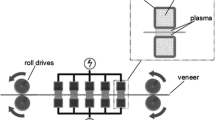Abstract
An investigation was carried out on the influence of a number of relevant factors which, in the case of hot press gluing i.e. conduction gluing (CG) and high-frequency (HF) gluing of peeled beech veneer (Fagus silvatica L.) to produce veneer boards, result in a permanent thickness loss of the boards. Using both types of gluing, four different thicknesses of veneer, four different veneer humidities, and four different gluing pressures were varied to make a large number of different combinations. Gluing of a total of 384 test boards 500×200 mm, with a thickness of approximately 15 mm, was carried out using urea-formaldehyde glue at a temperature of 120 °C. The gluing lasted for 8 minutes for hot press gluing, and 5 minutes for the HF method. The results of the tests showed that the interdependencies noted between the effects of the studied factors were similar for both methods of gluing. Influence of humidity on thickness loss was greater in the case of HF gluing and premanent thickness loss was greater for high frequency gluing.
Zusammenfassung
Untersucht wurden die Einflüsse einiger relevanter Einflußgrößen, die bei der Verleimung in einer Kontaktheißpresse (CG) bzw. mit Hochfrequenz (HF) von Buchenschälfurnier (Fagus silvatica L.) zu einem dauerhaften Dickenverlust führen. In beiden Verleimungsverfahren wurden vier Dicken, vier Feuchtegehalte und vier Verleimdrücke untereinander kombiniert. Dabei wurden 384 Probestücke des Formats 500×200×15 mm mit Harnstoff-Formaldehydleim bei 120 °C verleimt. Die Verleimungszeit betrug 8 Minuten bei Verleimung in der Kontaktheißpresse und 5 Minuten bei der HF-Verleimung. Die Ergebnisse der beiden Verleimungsarten zeigen ähnliche Zusammenhänge zwischen den untersuchten Einflußgrößen. Allerdings hatte die Furnierfeuchte bei der HF-Verleimung einen größeren Einfluß auf den Dickenverlust. Bei der HF-Verleimung wurden höhere dauerhafte Dickenverluste ermittelt als beim Verleimen in der Kontaktheißpresse.
Similar content being viewed by others
5 References
Bodig, J.;Jayne, B. A. 1982: Mechanics of Wood and Wood Composites. Van Nostrand Reinhold Company, New York Cincinnati Toronto London Melbourne
Currier, R. A. 1962: Compression of Douglas-fir plywood in various hotpressing cycles. Oregon For.res.Lab. No. 17
Fukuhara, Y.; Nakazava, H.; Omoto, H. 1976: Studies on the compressibility of wood materials. 2. On the deformation in compression perpendicular to grain of wood veneer. Bulletin of the Utsonomya University Forests, No. 12/13: 17–32
Gupta, R. C.;Shah, R. S. 1983: A preliminary note on compression loss in plywood. Indian Forest 109: 159–163
Lu, J. B. 1982: A preliminary study of fast hot pressing in plywood manufacture. Industry of Forest Products Linchan Gongy 5: 9–11
Krpan, J. 1970: Tehnologija furnira i ploča (Veneer and plywood technology). Tehnička knjiga, Zagreb
McDonald, M. D. 1951/52: Compression of Douglas-fir veneer during pressing. Part 1, Part 2, Timberman 4: 98–102, 5: 86–92
Wellons, J. D.;Krahmer, R. L.;Sandoe, M. D.;Jokerst, R. W. 1983: Thickness loss in hot-pressed plywood. Forest Prod. J. 33: 27–34.
Author information
Authors and Affiliations
Rights and permissions
About this article
Cite this article
Resnik, J., Tesovnik, F. Thickness loss when gluing veneer sheets into boards in the hot press or by high-frequency. Holz als Roh-und Werkstoff 53, 113–115 (1995). https://doi.org/10.1007/BF02716405
Issue Date:
DOI: https://doi.org/10.1007/BF02716405




